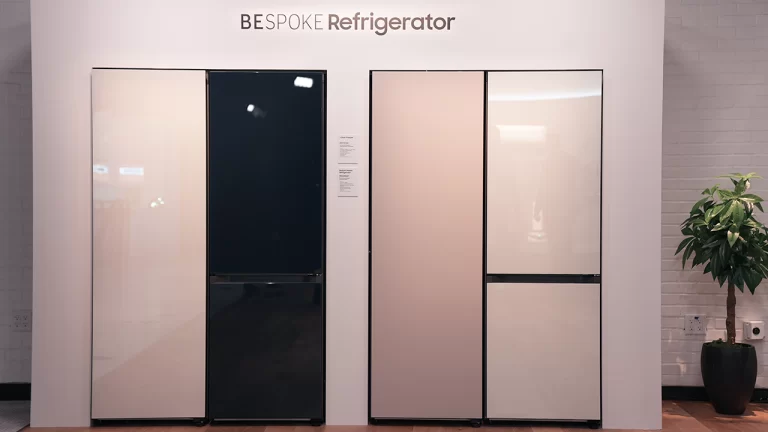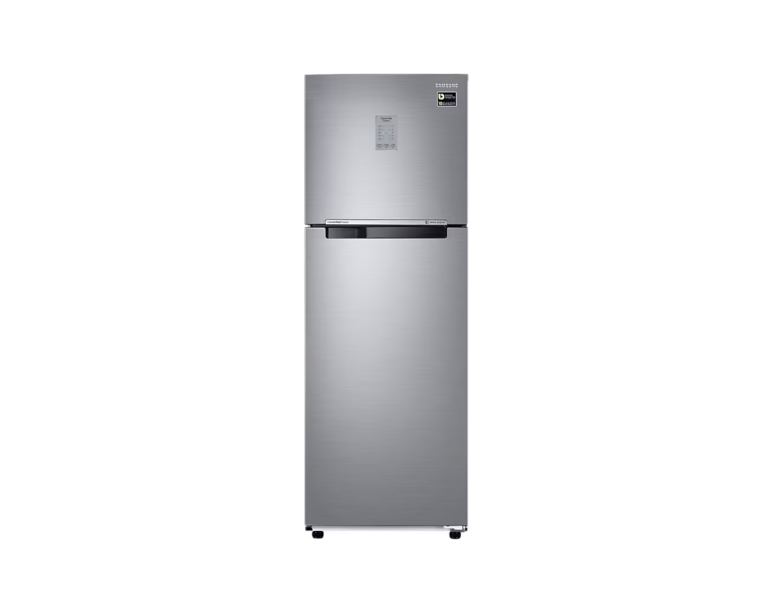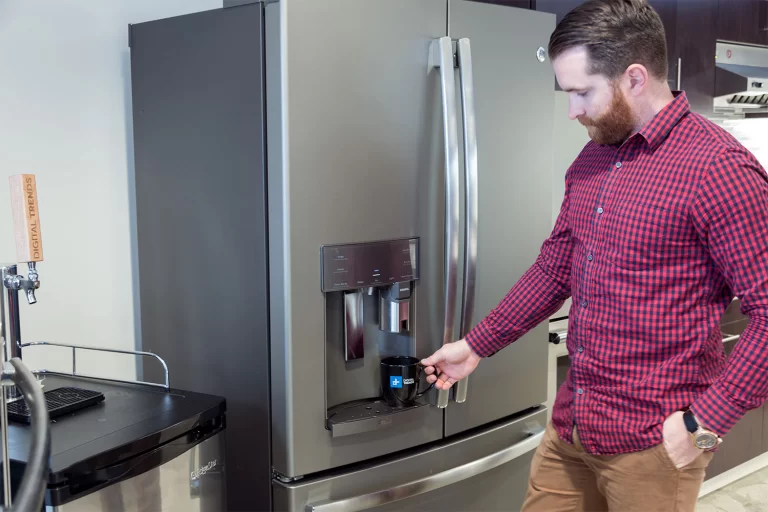General Electric (GE) holds a prominent place in the realm of home appliances, known for its blend of dependability and innovation. The side-by-side models of GE refrigerators are especially favored due to their aesthetically pleasing design and practical features. Nevertheless, no appliance is immune to occasional hiccups, and a frequently encountered problem is the GE side-by-side refrigerator not cooling but the freezer is working. Through this article, we will furnish you with an all-encompassing guide to tackle this specific issue, so your refrigerator resumes its efficient performance and keeps your food preserved safely.
When a GE side-by-side refrigerator is not cooling but the freezer is working, it may be due to a blocked damper preventing cold air from the freezer reaching the refrigerator. Other causes include incorrect temperature settings, blocked air vents, or a malfunctioning evaporator fan. Regular maintenance and checking component functionality can help resolve this issue.
Quick Troubleshooting Guide
| Issue | Symptoms | Potential Fixes |
| Improper Temperature Settings | Refrigerator too warm or too cold. | Adjust the temperature settings according to the manufacturer’s recommendations. Refrigerator: at or below 40°F (4°C), Freezer: 0°F (-18°C). |
| Blocked Air Vents | Refrigerator not cooling efficiently, uneven temperature distribution. | Rearrange food items to ensure they are not blocking vents. Clean vents if they are dusty or dirty. |
| Faulty Damper Control | Refrigerator section not cooling, but freezer is fine. | Check the damper for obstructions or damage. If it’s not opening properly, it may need replacement. |
| Dirty Condenser Coils | Both compartments are not cooling efficiently, refrigerator running constantly. | Clean the condenser coils with a coil brush or vacuum. Recommended to do this every six months. |
| Malfunctioning Evaporator Fan | Noisy operation, frost buildup in freezer, refrigerator not cooling efficiently. | Check the evaporator fan for obstructions or noise. If it’s not running properly, it may need to be replaced. |
| Defrost System Failure | Frost buildup in the freezer, refrigerator not cooling. | Check the defrost heater, defrost thermostat, and timer. If any of these components are faulty, they will need to be replaced. |
| Faulty Thermostat | Refrigerator not cooling or too cold, compressor not turning on. | Test the thermostat with a multimeter. If it’s not functioning correctly, replace it. |
| Leaking Door Seal | Condensation around the door, refrigerator not maintaining temperature. | Check the door seals for cracks or gaps. Clean them or replace if necessary. |
| Faulty Compressor | Compressor not turning on, both refrigerator and freezer not cooling. | This is a complex issue. It’s recommended to contact a professional technician for diagnosis and repair. |
Understanding the GE Side-by-Side Refrigerator Design

GE’s side-by-side refrigerators are designed with the freezer and refrigerator sections sitting next to each other, catering to different storage needs. Understanding the cooling system in these models is crucial for effective troubleshooting. The system relies on a single compressor that cools both sections. The freezer usually takes priority, and the cool air is then distributed to the refrigerator section via a damper.
The Unique Side by Side Design and Different Refrigerator Sections
This design allows for easy access to both fresh and frozen foods. The compartments typically have dedicated shelves and drawers to optimize storage.
How the GE Refrigerator Cooling System Operates
The compressor compresses refrigerant, turning it into a high-pressure gas. This gas travels through the condenser coils, releasing heat and becoming a liquid. It then moves through the evaporator coils, absorbing heat and cooling the interior.
Distinction Between the Refrigerator and Freezer Sections in GE Models
The temperature and airflow are controlled separately in each section, allowing for different climates in the refrigerator and freezer compartments.
Learn More: GE refrigerator water dispenser not working but ice maker is
Delving into Common Causes of GE Refrigerator Not Cooling
1. Temperature Settings
The Role of Correct Temperature Settings in Refrigerator Performance:
Correct temperature settings are essential to keep the refrigerator running efficiently. The refrigerator should be kept at or below 40°F (4°C), and the freezer at 0°F (-18°C) for optimal food safety.
How to Properly Set the Temperature for Optimal Food Safety:
Check your GE refrigerator’s manual for specific instructions. Typically, you can adjust the temperature via a digital control panel.
2. Airflow Issues in GE Refrigerator
The Importance of Proper Air Circulation and Unblocked Vents:
Air circulation is crucial for consistent cooling. Ensure that the vents are not blocked by food items and that there is enough space between the refrigerator and walls for airflow.
Identifying and Fixing Airflow Issues for Better Cooling:
Regularly check for obstructions and maintain cleanliness in vents and fans. Adjust the placement of food items to ensure vents are not blocked.
4. Damper Control in GE Side by Side Refrigerators
The Critical Function of Damper Control in Cooling:
The damper controls the amount of cold air entering the refrigerator from the freezer. If it malfunctions, the refrigerator may not receive enough cold air.
Troubleshooting and Repairing Damper Issues:
Check if the damper is stuck or broken. If it is, you might need to replace it. Consult your refrigerator’s manual for instructions.
5. Defrost System Problems in GE Refrigerators
The Role of the Defrost System in Refrigerator Performance:
The defrost system prevents the evaporator coils from icing up. If it malfunctions, the coils can ice over, preventing cold air from circulating.
Diagnosing and Fixing Defrost System Malfunctions:
Check the defrost heater, defrost thermostat and timer. If any of these are faulty, you will need to replace them.
6. Cleaning and Maintenance of Condenser Coils
How Dirty Condenser Coils Affect Cooling:
Dirty condenser coils cannot release heat effectively, which can cause the refrigerator to work harder and not cool properly.
Tips for Cleaning and Maintaining Condenser Coils:
Use a coil brush or vacuum to clean the coils every six months or as recommended by the manufacturer.
Read: GE refrigerator water dispenser not working but ice maker is
7. Evaporator Fan and Condenser Fan
The Functions of Evaporator and Condenser Fans in Cooling:
These fans circulate air over the evaporator and condenser coils. If they malfunction, cooling will be affected.
How to Identify and Resolve Issues with Fans:
Listen for unusual noises or check for frost buildup, which may indicate fan issues. Replace faulty fans.
8. GE Refrigerator Thermostat Issues
Understanding the Thermostat’s Role in Cooling:
The thermostat senses the temperature inside the refrigerator and sends signals to the compressor to start or stop.
Diagnosing and Replacing a Faulty Thermostat:
If the refrigerator is not cooling but the freezer is, the thermostat might be faulty. Check it using a multimeter, and if it’s faulty, replace it.
When to Seek Professional GE Refrigerator Repair Service

Identifying Complex Problems Beyond DIY Repair
If you’ve tried the above troubleshooting steps without success, the problem might be more complex and require professional attention.
The Risks of Handling Certain Repairs Without Professional Training
Tampering with electrical components and refrigerants can be dangerous. It’s important to know when to seek help to avoid personal injury or further damaging the appliance.
How to Find a Reputable Appliance Repair Service for GE Refrigerators
Look for licensed technicians with positive reviews and experience in repairing GE appliances.
What to Expect During a Professional Repair Service for GE Appliances
A professional technician will diagnose the issue, provide you with an estimate, and perform the necessary repairs.
Interesting Read: GE monogram refrigerator problems
Essential Preventive Maintenance and Appliance Care Tips for GE Side-by-Side Refrigerators

Routine Maintenance Tasks to Prolong Appliance Lifespan
Regularly cleaning coils, checking vents, and ensuring proper temperature settings can prolong your refrigerator’s lifespan.
Recommended Temperature Settings and Usage Tips for Optimal Cooling
Keep the refrigerator at or below 40°F (4°C) and the freezer at 0°F (-18°C). Avoid overloading the refrigerator, as this can affect airflow.
Cleaning and Care Tips for Maintaining High Refrigerator Performance
Clean the interior and exterior regularly, and check door seals for proper sealing.
FAQs
What is the ideal temperature setting for the refrigerator and freezer sections in a GE side-by-side refrigerator?
The ideal temperature for the refrigerator section is at or below 40°F (4°C) to keep food fresh and safe. The freezer section should be set at 0°F (-18°C) to maintain the quality of frozen foods.
How often should I clean the condenser coils on my GE side-by-side refrigerator, and why is it important?
It is recommended to clean the condenser coils every six months. Clean coils allow the refrigerator to release heat more efficiently, which is essential for proper cooling. If the coils are dirty, the refrigerator may have to work harder, which could lead to increased energy consumption and potential cooling issues.
My GE side-by-side refrigerator is making unusual noises and not cooling properly. What could be the cause?
Unusual noises accompanied by cooling issues could be due to a malfunctioning fan (evaporator or condenser), a problem with the compressor, or an issue in the defrost system. It’s essential to identify the source of the noise and address the underlying issue. Consulting a professional technician is advised if you’re unfamiliar with refrigerator repairs.
The freezer in my GE side-by-side refrigerator is working, but the refrigerator section is warm. Is it safe to continue storing food in the freezer section?
If the freezer is maintaining the correct temperature (0°F or -18°C) and is functioning properly, it should be safe to continue storing food there. However, it’s important to address the issue with the refrigerator section not cooling promptly to avoid food spoilage and to ensure that the appliance is working efficiently.
Where can I find replacement parts for my GE side-by-side refrigerator if I need to replace a damper control, thermostat, or fan?
You can purchase replacement parts for your GE side-by-side refrigerator through the official GE Appliances website, authorized dealers, or reputable online marketplaces like Amazon and eBay. Make sure to check for compatibility with your specific refrigerator model before making a purchase.
Conclusion
In conclusion, encountering a situation where your GE side-by-side refrigerator is not cooling but the freezer is working can be frustrating. However, as we’ve discussed, this issue can often be resolved through some basic troubleshooting and maintenance. Whether it’s cleaning the condenser coils, ensuring the air vents are unblocked, or replacing a faulty damper, taking the right steps can make a significant difference. Sometimes, professional help may be required, especially for complex repairs. Regular maintenance and vigilance can help in preventing such issues in the first place.






